
by Rick O'Connor | Oct 2, 2015
While directing the Marine Science Academy for the Escambia County School District I had students conduct small, informal, surveys targeting the popularity of seafood with students, parents, and the community. The purpose of these surveys was to kick start a discussion on the commercial fishing issue. The northern Gulf Coast has been known for several popular seafood products over our history; oysters, blue crab, mullet, snapper to name a few. There are two basic paths a commercial fishery can move as they grow their business. Fish for what they know and is easily harvested and convince the public to purchase – marketing. OR they can find out what the public wants and then develop a fishery to target those species. Hopefully they will find common ground; something that is available, easy to harvest, and popular with the public.
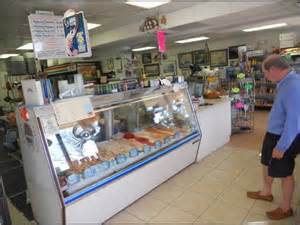
There are about 80 species of commercial seafood products that come from Florida.
Photo: Florida Sea Grant
In those surveys we looked at young and old, male and female. A couple of trends became apparent over the 20+ years we conducted these (remember, low level high school survey… but still interesting). (1) Shrimp was the no.1 favorite with all groups. That’s good, shrimping in the northern Gulf is a do-able product – many will say the best shrimp comes from these waters. But we also know that shrimping has hit hard times; more on this next week.
(2) With males No.2-5 are typically fish, with females it varies from fish to calamari, to sushi, to other. Popular fish of course are grouper and snapper… and we all know the issues with these target species in our area. There are lesser known fish with the general public, though many locals know, such as sheepshead, tilefish, pompano, that are not typically on menus. And of course a local favorite… mullet. With the mix request beyond fish include squid, crab, sushi grade fish, lobster, and others. Some of these are not common in our area and must be transported in. For many where the fish comes from does not really matter – for others it does (more on this in our last addition this month). But as you can see this type of information plays a role on how the seafood business works in the northern Gulf.
(3) The first question on the survey was “do you like seafood?” Of course if the answer was no then it was not necessary to ask further questions. The trend we saw over time was more and more stating they did not like it. Curious… I mean there are things I do not like either – so there is no problem not liking seafood – but we were curious as to why… so we added that to the survey. Our thought as we began was seafood safety. At the time much of the seafood landed was sold at a wholesale or retail market with little or no inspection – did this concern folks? In our survey we found that in most cases it did not. They just did not like the taste… fair enough.
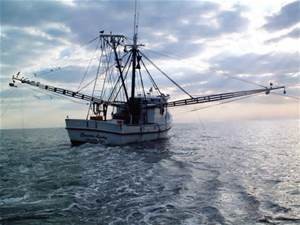
Shrimping.
Photo: NOAA
What do the bigger surveys say? In 2014 an article was posted in the Wall Street Journal discussing this issue and what other surveys found. (1) There was a decline consumption. In 2012 Americans consumed an average of 14.4 lbs of seafood/person. This was down from 15.0 lbs in 2011 and 16.6 lbs in 2004. For comparison, at that time Japanese consumed 120 lbs/person/year and Spain consumed 96 lbs. To compare this with the “big three” at that time Americans consumed 46 lbs of pork, 57 lbs of beef, and 82 lbs of chicken/person/year. Chicken is king… it is a white meat, Americans are trying to eat healthier, but fish is a white meat… so why not fish?
The surveys indicated the top reasons were
- Do not know how to cook
- The price of seafood is high
- Marketing – the seafood industry is fragmented and marketing efforts on the healthy benefits have not happen (or if done, were not done as well as the focused effort of the chicken industry).
To a lesser extent there was concern over safety (particularly mercury) and some concern about genetically modified farm raised fish (salmon in particular was mentioned). Members of the chicken industry highlighted the cost of production for seafood as a barrier for them. It cost more to go to sea and harvest seafood (or raise salmon in ocean pens) than it does to produce the “big three” on farms.
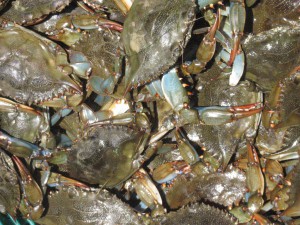
The crab of choice in the northern Gulf of Mexico; blue crab.
Photo: FWC
This year Florida Sea Grant published an article in the September issue of Florida Trends on this issue. Sea Grant pointed out that currently the national consumption of seafood is up to 15 lbs and that Floridians consume 31 lbs/person/year… so there is a trend upwards since the Wall Street Journal’s 2014 article. However 40% of Floridians do not consume 2 servings a week (as suggested by the U.S. Department of Agriculture).
We can state that seafood is healthy for you and it is safe to consume (check out Florida Sea Grant for more on this). What I am finding is that there is a small group of locals now concerned with whether the seafood they are consuming is coming from local fishermen. We will discuss more on these topics in later editions.
Enjoy seafood.

by Rick O'Connor | Oct 2, 2015
They are marvelous creatures and there are very few panhandle residents who know what they are. My wife and I were introduced to Diamondback Terrapins by George Heinrich in 2005. George was the president of a nonprofit, Florida Turtle Conservation Trust, and a member of the Diamondback Terrapin Working Group, a national group of terrapin researchers and educators. He, and these organizations, were very interested in the status of terrapins in the Florida panhandle… so Molly and I took that job on.
Diamondback terrapins (Malaclemmys terrapin) are the only true brackish water resident turtle in the United States. They range from Cape Cod MA down the entire eastern seaboard, across the Gulf of Mexico to Brownsville TX. Within that range there are 7 described subspecies, 5 of those found in Florida, 2 found in the Florida panhandle. These estuarine turtles prefer salt marsh and mangrove habitat. They are very reclusive and difficult to find – hence why most locals have never seen nor heard of them. When I talk about them to the public I get responses such as… “do you mean tarpon?” “I find those in my yard all of the time” (probably a different species), “aren’t those from up north?” and “never heard of them”… they are not fish so they could be found in your yard if you live along the fringes of a salt marsh, they are up north – but they are here also.
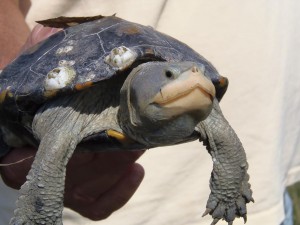
Diamondback terrapin found in Wakulla County.
Photo: Molly O’Connor
In 2005 Molly and I were asked to survey the panhandle and determine if terrapin populations still exist. We decided to take that job on and then expand to determine their population size and whether those populations are increasing or decreasing. The coastal panhandle extends from Escambia County (on the Alabama state line) to Jefferson County (Aucilla River), but due to existing funding we could only survey to the Apalachicola River. This would include six counties: Escambia, Santa Rosa, Okaloosa, Walton, Bay, and Gulf. We verified at least one record of a terrapin in each county. We discovered the larger the expanse of salt marsh – the higher probability of terrapins; thus those counties with relatively little salt marsh (such as Okaloosa) would have fewer/smaller terrapin populations.
But marsh alone is not enough. Terrapins need high ground in which to lay their eggs. High ground within a marsh is not a common thing. Research shows that terrapins will travel up to 5 miles in search of suitable nesting; which means a terrapin could be found in your neighborhood even if no marsh is visible. Unlike sea turtles they are “home-bodies” rarely leaving the marsh where they were born. They spend time forging for shellfish (particularly the snail called marsh periwinkle – Littorina irorata) and basking on and in the mud. They can be seen at the surface with their heads peering at you – they seem to be very curious.
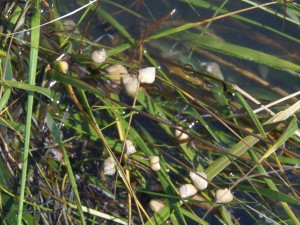
Marsh periwinkles will climb cordgrass to avoid predation by blue crabs and terrapins.
Photo: Molly O’Connor
Once we confirmed that terrapins were still in the panhandle we then began work on how many. To do this we needed to find their nesting beaches. Terrapin nesting season is about the same as that of sea turtles (May 1 – Aug 1); some nesting may occur after that but few. Unlike sea turtles they nest during daylight hours and prefer sunny days over cloudy/raining ones. They like to nest at high tide – thus finding a suitable location that is out of the way of potential flooding by the rising bay – however this does not account for severe storms. They typically lay about 10 eggs in their nest, cover and disguise, and then leave it to its fate. Unfortunately in many nesting areas, its fate is to be uncovered and consumed by predators – particularly raccoons. Molly and I would kayak salt marshes searching for suitable nesting beach. Once found, we would walk the beach looking for sign of nesting. If nesting was found this would be recorded and we would then begin 16-day monitoring trips. It is assumed that each sexually mature female within the population will nest once every 16 days; and they will nest more than once each year. Signs of nesting include tracks (which are counted), and egg shells from a nest that was raided by a raccoon (which were logged and removed). Occasionally we would come across a nesting female. We would allow her to complete the nesting activity and then capture her for measurements and photographs. We would mark her with a notch on the margin of the carapace (top shell) and release her (we did not have the funding for PIT tags). We would also set modified crab traps to capture them. Terrapins have a habitat of entering crab traps (probably more for the bait than the crabs) and becoming entrapped. Unless found within 15-30 minutes, they will drown. Our modified crab traps were tall enough that terrapins could reach the surface (even at the highest tide) and get a breath of air. We would set traps for 5 day periods and (if we caught any at all) would only capture during the first day or two. Terrapins are smart and we found that after day 2 most would approach our traps, observe our handy work, and swim away. With the data from these two activities we could get a rough idea of how many terrapins were in this population and how they changed over time.
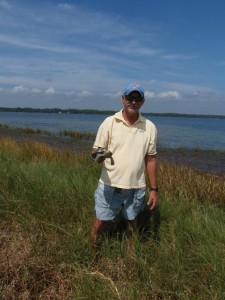
The marshy habitat terrapins love.
Photo: Molly O’Connor
We focused our population surveys to our home counties of Santa Rosa and Escambia counties. We were able to identify 1 nesting beach in Escambia and 2 in Santa Rosa (we have since found a 3rd). We never caught a terrapin in Escambia but had good success at one of the two beaches in Santa Rosa. That population had approximately 50 individuals living within it. From 2007 to 2012 the population remained relatively stable. In 2012 I changed jobs and have not had a chance to re-survey. I plan to do this in 2016.
This year we trained 24 volunteers to assist us in locating and monitoring nesting beaches. They did find a new nesting beach in Santa Rosa and will begin monitoring nesting activity and trapping next year.
These are fascinating creatures and one of the most beautiful turtles you will ever see. Some have asked me about state protection for them. They are listed as a freshwater turtle with FWC thus you cannot possess more than two, cannot have any eggs, and cannot sell them.
If you have questions about diamondback terrapins, are interested in participating in terrapin surveys in Escambia and Santa Rosa counties, or would like to begin your own surveys in your county. Contact me (Rick O’Connor) at roc1@ufl.edu or (850) 475-5230.

by Erik Lovestrand | Oct 2, 2015
Anyone who has had a treasured palm tree annihilated by palmetto weevils (Rhynchophorus cruentatus) knows the pain of losing a long-lived tree from the home landscape. These large, native weevils are adept at working unnoticed inside a palm to the point of terminal damage. Typically, by the time you notice that the tree is declining and fronds begin to turn brown there is likely no hope of salvaging the situation. By then the larval grubs have already damaged the tree’s growing bud to the point of no return. At this stage the recommended procedure involves removing the tree, cutting it up and burning it to prevent the invading long-snouted critters from moving over to neighboring palms.
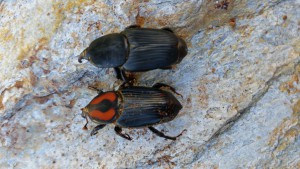
Color and size of adults is quite variable.
However, as frustrating as this is, if we step back and look at the bigger picture it is apparent that even our most aggravating native insect pests are part of the natural web of life and local plants have adapted to survive these “give and take” relationships on the population scale.
Palmetto weevils establish in a new tree when adult females lay their eggs in the crown of the tree and larvae hatch to burrow into the soft terminal bud. It is larval feeding that does the lethal damage. Larvae are large, white, legless grubs that can reach lengths of six-seven centimeters. When larvae are mature they create a cocoon inside the tree from tree fibers and pupate there before hatching into adults to start the cycle over. Grubs can be found in any part of the tree but really need the softer, growing parts for food, such as in the base of the living fronds and the terminal bud.

Weevil damage at base of frond.
The condition created by these burrowers is often referred to as “popped neck,” where the top of a palm tree dies and caves over. If you are in the process of removing a dying or dead palm due to the crown dying it would be a good idea cut through the top section with a chainsaw to see if weevil damage is evident in large (about ½ inch) diameter tunnels. If a live specimen of an adult can be captured in a jar it would be worth a visit to your local Extension office for a positive identification to make sure you aren’t dealing with another similar species of non-native weevil that has not been documented in Florida yet. The red palm weevil (Rhynchophorus ferrugineus) has now been found in the U.S. at Laguna Beach, California. Coloration varies by individual bug but a positive i.d. can be obtained by sending the specimen to UF’s laboratory in Gainesville. For further information on palmetto weevils refer to the EDIS fact sheet at this web link.
by Mark Mauldin | Oct 1, 2015
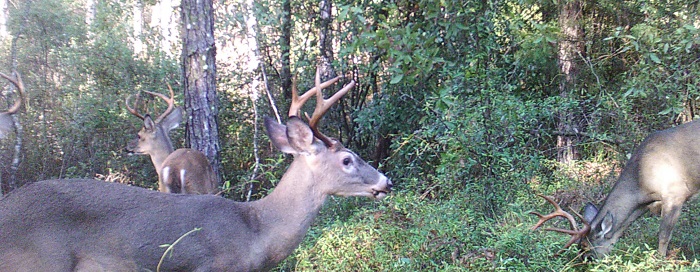
As summer browse dwindles the habitat improvement associate with wildlife food plots becomes even more evident.
Photo Credit: Mark Mauldin
Improving habitat can benefit the quantity and quality of wildlife on a piece of property. One common method for improving habitat is the establishment of food plots. Food plots are simply areas that are managed for the production of forages that help meet the nutritional requirements of the desired wildlife species.
The implementation of food plots has gained popularity largely through its association with hunting, specifically white-tailed deer hunting. Food plot establishment and hunting success can be directly related; attracting game to a specific area via the establishment of a highly desirable plant species. That said, rarely are food plots which are planned and utilized only as attractants very successful. Truly successful food plots are developed with yearlong habitat improvement in mind; improved hunting on the property is a by-product of the improvement in habitat.
Successful implementation of wildlife food plots takes planning and consideration. Many factors must be considered;
- Site selection: Factors like size, shape, soil characteristics, and location can greatly affect the potential success of a food plot.
- Nutritional demands of wildlife: Throughout the course of the year the nutritional demands of wildlife change. Wildlife, especially deer, will show preferences for different plants at different times of the year based largely on the nutritive value of the plant. Successful food plots seasonally match the nutrition offered to the nutrition need by the wildlife.
- Plant selection: Selecting the best species and varieties to plant in a food plot is a decision that tends to get a lot of attention, and rightfully so. Plantings should be selected based on how well they are adapted to the site, propensity of wildlife to utilize them, and how well they fit into the yearlong rotation. It is always advisable to plant a blend of multiple species, planting windows and persistence of the plants must be considered when formulating these blends.
- Agronomic practices: If all other factors are considered and appropriately addressed the success of a food plot is still dependent on the ability of the land manager to effectively plant and manage the crop(s). Soil fertility, weed control, planting depth, seeding rate, etc. all need to be correctly addressed to have a successful food plot.
Planning and hard work are prerequisites for successful food plots but when everything comes together seeing the benefits they provide can be a truly rewarding experience. If you are interested in learning more about successfully improving wildlife habitat through the implementation of food plots please consider attending Wildlife Food Plot Fundamentals. This workshop will be at the Washington County Agricultural Center on Thursday October 8th beginning at 6:30pm. Please see the flyer for more details, for questions or to register contact Mark Mauldin with UF/IFAS Extension, Washington County (850-638-6180, mdm83@ufl.edu).
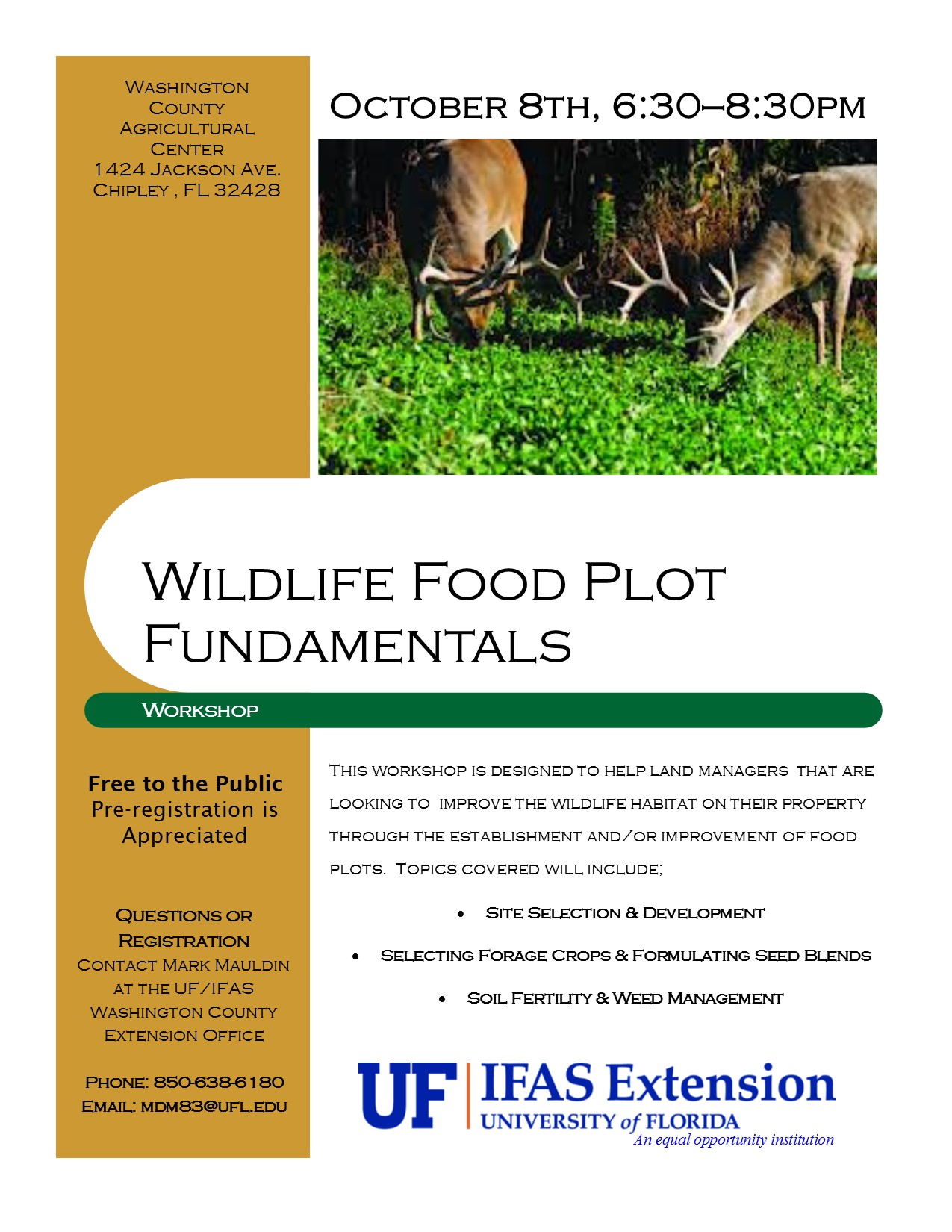

by Rick O'Connor | Oct 1, 2015
Do you have any exotic pets you can no longer care for? Would you like the opportunity to surrender those pets without any penalties or fines? Then join the Florida Fish and Wildlife Conservation Commission (FWC) and Gulfarium Marine Adventure Park for an Exotic Pet Amnesty Day on Oct. 3 in Fort Walton Beach.
This free event is open to the public and will be held in front of Gulfarium Marine Adventure Park, 1010 Miracle Strip Parkway SE, Fort Walton Beach. Admission to the park is not included. Surrendered animals will be accepted between 10 a.m. and 2 p.m. These animals will be checked by a veterinarian and made available for adoption by experienced individuals who are capable of caring for them.
Animals that will be accepted for surrender include reptiles, amphibians, mammals, birds, fish and invertebrates. Domestic animals, such as cats and dogs, will not be accepted. For each animal surrendered, individuals will receive two free admission passes to the Gulfarium.
Animals will be available for adoption after 2 p.m. Exotic pet adopters must be experienced and must have already applied and been approved by the FWC prior to the event. Potential adopters need to bring their acceptance letters with them. People can find adopter applications at MyFWC.com/Nonnatives. Becoming an adopter is free, but people are required to register a minimum of five days prior to the event to adopt an animal.
Experts from the FWC, Gulfarium Marine Adventure Park and other local organizations will be on hand with information about caring for exotic pets, responsible pet ownership and potential ecological impacts of invasive species in Florida. Families can enjoy the opportunity to see several species of exotic animals and participate in crafts and games.
For additional information about this event, call the FWC’s Exotic Species Hotline at 888-Ive-Got1 (888-483-4681). Exotic pet owners who cannot attend this event may call this number for assistance in finding a new home for their animal.
For more information about Gulfarium Marine Adventure Park, call 850-243-9046 or visit http://www.gulfarium.com/.














